
UC Berkeley Point of View
'Awful beauty': Reactions to '100 Suns' exhibit on Memorial Glade
| 'Suns' setting "100 Suns" is on display in Memorial Glade through Friday, Oct. 7; a selection of images from the book of the same name is posted on photographer Michael Light's website. The installation is part of a multidisciplinary "Arts and the Atomic Bomb" event series through the month of October. |
"100 Suns (For Robert, Ernest and Edward's Berkeley, 1945-1962)," a weeklong public "bookwork" commissioned by Berkeley's Graduate School of Journalism, documents the era of visible nuclear testing — an era in which UC Berkeley played a pivotal role. Photographer Michael Light has unearthed 100 photographs from government archives, including previously classified material from a facility in Hollywood, that capture the nightmarish shape of mushroom clouds as well as the awestruck faces of soldiers who witnessed them.
"The university's role as the primary architect of the nuclear arms race and the Cold War of the last century is surpassed only by the U.S. government itself … may every student at Berkeley understand their university fully," writes Light in the introduction to the Memorial Glade installation.
We asked eight viewers of "100 Suns" to share their reactions.
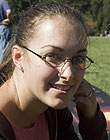 |
'Well, I'm
a combustion grad student,
so this is pretty intense.
It's amazing how beautiful
such a deadly thing can be.
It also makes me wonder whether
everyone who worked on them
knew how enormous and powerful
they are, how many megatons
of water they displaced,
for example.' —Jaime
Herren, first-year Ph.D.
student in mechanical
engineering. Hometown:
Vallejo, CA |
| 'I knew almost
all of these facts — not
what each test was called,
but I have seen a documentary
on Oppenheimer and read
Richard Feynman's "Surely
You're Joking" — but somehow
this is different.
Some things I knew but
was not conscious of, that
UC Berkeley was so involved
in the development of the
bomb. It's quite shocking
to have that sink in, that
60 years ago the university
I am attending was doing
that work. Also, even though
I knew this, too, it is shocking
to be reminded that after
1945, the politicians went
on with such tests — that
they didn't care what the
explosions on islands, the
exposure of the soldiers,
and the killing of thousands
of people had done.' —Matthias
Goerner, first-year Ph.D.
student in mathematics.
Hometown: Bremen, Germany. |
 |
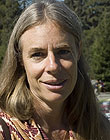 |
'It's depressing
and horrifying. Somebody
I know's father was one of
the soldiers in the pictures
who was present at a blast;
he died of leukemia. She
took part in a lawsuit seeking
compensation from the government,
but I don't know if it was
successful. So it makes me
think about her and also
about my teenage son. He's
a photographer and I think
he would like to see this.' —Ellie
Bush, visitor to campus.
Hometown: Vacaville,
CA |
| 'The photographs
are beautiful, but should
they be? It's eerie how beautiful
but wrong they are at the
same time — an evil, awful
beauty.' —Martijn
Van Duijn, bioengineering
postdoc. Hometown: Leiden,
The Netherlands |
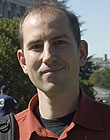 |
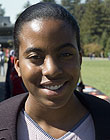 |
'It's amazing
looking at all these pictures
and seeing all the destruction
these bombs could cause.
I couldn't believe they put
soldiers only a few miles
from the tests. It's kind
of an eye-opener. It's really
scary to think all this is out
there — you never know what
could happen.' —Ashley
Clark, second-year student
(undeclared). Hometown:
Sacramento, CA |
| 'I think it's
really great the Journalism
School is doing this because
I'm sure there are a lot
of kids here who don't know
about the university's involvement
in creating nuclear weapons.
I did know, but
not about the troops being
so close to the blasts. That
was really disturbing — those
pictures of people watching
the blasts with just goggles
on. Also, I was amazed by
the beauty of the photos.' —Jake
Himmel, fifth-year architecture
student. Hometown: Palo
Alto, CA. |
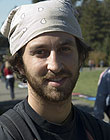 |
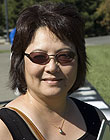 |
'I didn't
know there had been some
200 tests, and that there
were people sitting that
closely to them, until I
saw the photos. I think some
of those photos had been
classified until now. You
know, lots of times you can
read about something or see
a movie, but when you see
the real thing, you get a
different impression — it
really impacts you so much
more.' —Susan
Hsueh, Graduate Assembly manager.
Hometown: Moraga, CA |
| 'I found
the photos disturbing yet
beautiful. I didn't know
the quantity of bombs that
had been detonated. I guess
I did know that the university
was involved but not the
scale of the involvement.
It's shocking but interesting,
too.' —Brittain
Gulden, fourth-year mechanical
engineering student.
Hometown: Ventura, CA. |
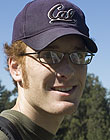 |
Have a suggestion for a Point
of View topic? Send an e-mail
to bpowell@berkeley.edu.
Answers to previous surveys are
available from the Point of
View archive.
